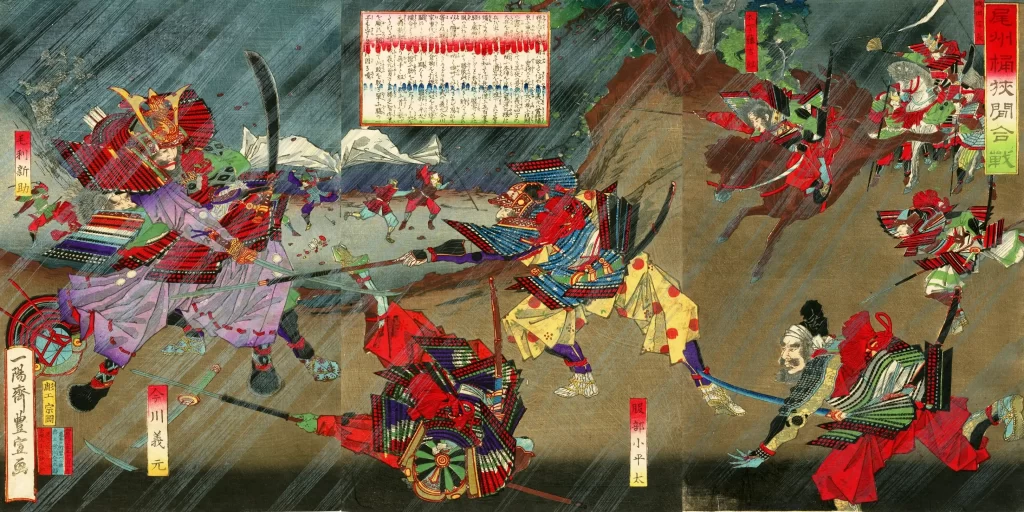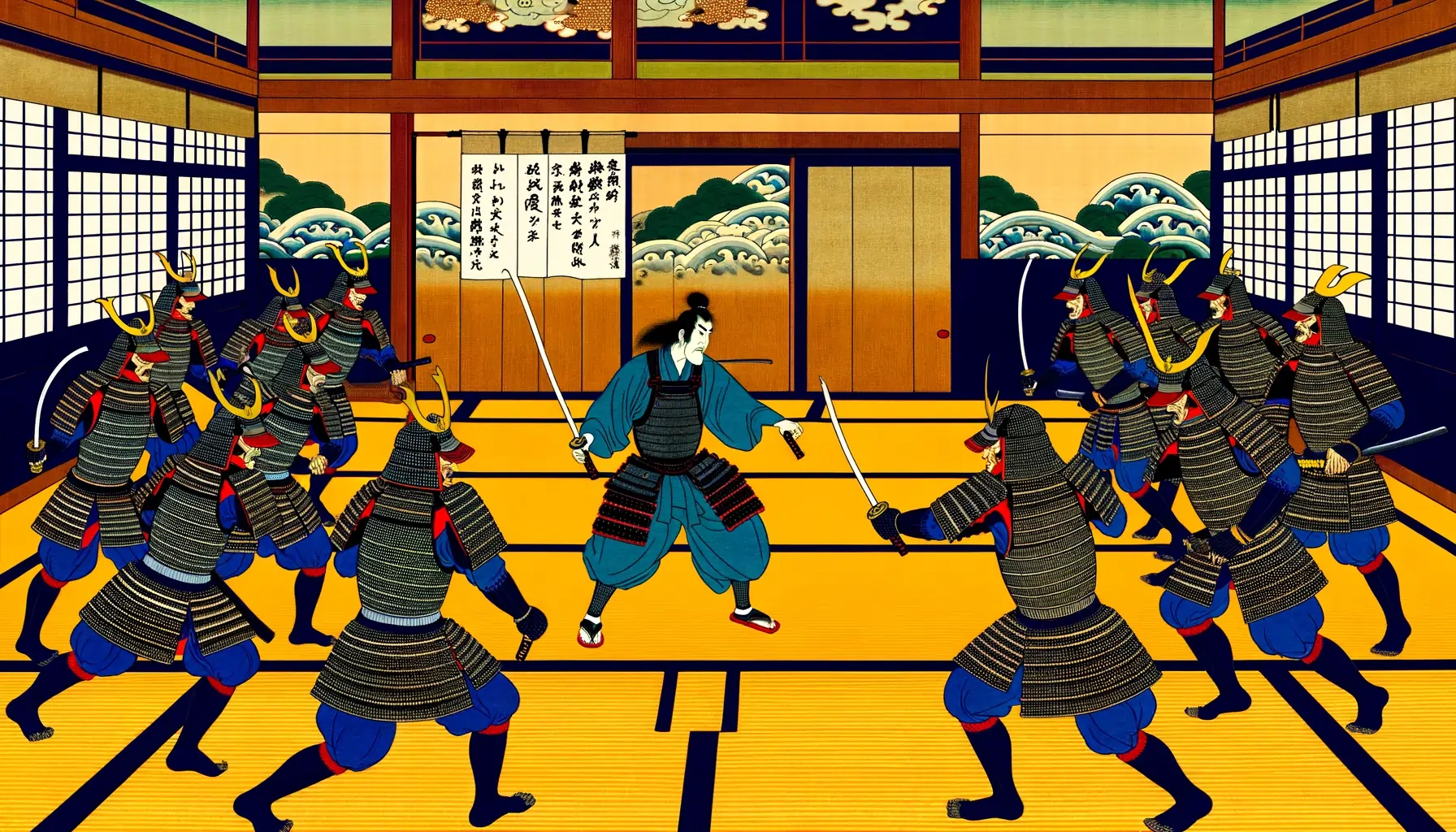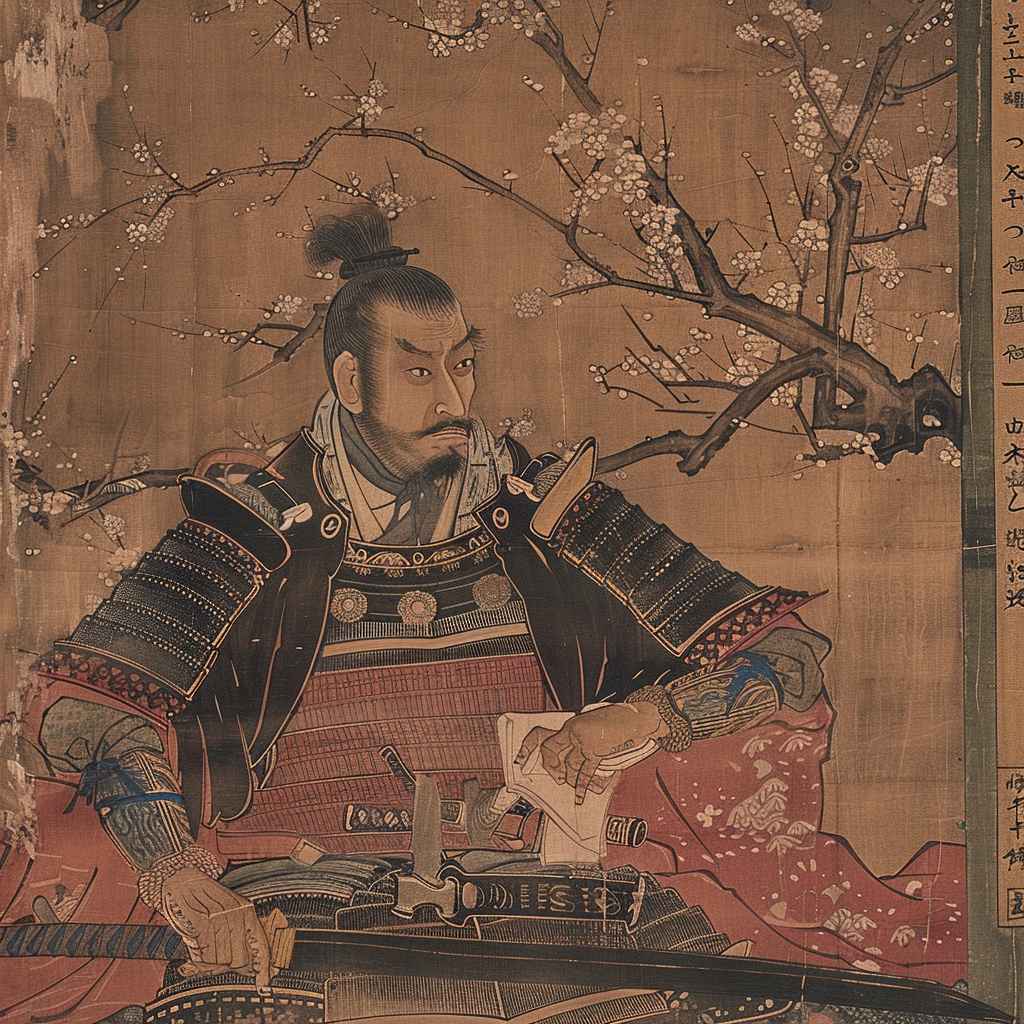Introduction
Oda Nobunaga stands as one of history’s most formidable figures, whose strategic acumen and indomitable will played a pivotal role in the tumultuous Sengoku period of Japan, a time characterized by incessant warfare and the fracturing of the country into competing feudal domains. Born in 1534 in Owari Province, Nobunaga emerged from a relatively modest status among warlords to become one of the most powerful and influential figures in Japan. His life’s work laid the foundational steps toward the unification of Japan, a monumental achievement that would be realized fully by his successors.
The Sengoku period, often translated as the “Age of Warring States,” was a century-long era of military and political upheaval. In this period, daimyos (feudal lords) vied for power, land, and influence, leading to a fragmented and unstable Japan. Nobunaga’s emergence as a dominant force during such times was as unexpected as it was transformative. Known in his youth as the “Fool of Owari” for his unconventional behavior and ideas, Nobunaga would later leverage these very traits to outmaneuver his rivals and begin the process of consolidating power.
Through a combination of military innovation, strategic marriages, and ruthless determination, Nobunaga began to assert his influence over Japan. His victory at the Battle of Okehazama in 1560 against the much larger force led by Imagawa Yoshimoto not only marked his arrival on the national stage but also demonstrated his adeptness at turning the tide of battle in his favor through surprise and innovation. This battle was just the beginning of Nobunaga’s campaign to unify Japan, a journey marked by both brilliant success and brutal conflict.
In this blog post, we will delve into the life and legacy of Oda Nobunaga, exploring his early years, his strategies and innovations, his campaigns for unification, his religious policies and cultural impact, and, finally, his downfall and enduring legacy. Nobunaga’s story is not just one of military conquests but also of significant cultural and economic reforms that propelled Japan towards a new era. As we uncover the layers of Nobunaga’s complex character, we will gain insight into the qualities that made him a key figure in Japanese history and reflect on the lessons contemporary society can draw from his relentless pursuit of unification and reform.
Early Life and Rise to Power
Oda Nobunaga was born in 1534, into a world of constant conflict and power struggles, in the Owari Province, which is present-day Nagoya in Aichi Prefecture. As the son of Oda Nobuhide, a minor daimyo and warlord of the Oda clan, Nobunaga’s prospects, while promising, were not indicative of the immense impact he would eventually have on Japanese history. His early life was marked by rebellious behavior and an apparent disregard for the traditional samurai code of conduct, earning him the nickname “Fool of Owari.” This unconventional attitude, however, would later prove to be one of his greatest assets, setting him apart from his contemporaries in both thought and deed.
Ascension Amidst Chaos
Following the death of his father in 1551, Nobunaga entered into a period of internal conflict and power struggles within the Oda clan. Despite opposition from family members and rival factions, Nobunaga’s decisive and often ruthless actions eventually secured his position as the head of the clan. His method of dealing with dissent showcased his willingness to break from tradition and enforce his authority through whatever means necessary, characteristics that would define his approach to unifying Japan.
The Battle of Okehazama

The turning point in Nobunaga’s rise to power came in 1560 at the Battle of Okehazama. Facing an army led by Imagawa Yoshimoto, which vastly outnumbered his own, Nobunaga leveraged his intimate knowledge of the local terrain and his bold, unconventional tactics to launch a surprise attack during a downpour. The victory was staggering; Imagawa was killed, and his forces were decimated, catapulting Nobunaga from a regional lord to a major player in the political landscape of Japan. This battle not only demonstrated Nobunaga’s military genius but also his audacity and willingness to take risks that others would shy away from.
Consolidation of Power
Following his victory at Okehazama, Nobunaga began a meticulous campaign to consolidate his power. He forged alliances with other powerful families, like the Matsudaira (later Tokugawa) clan, and used these relationships to isolate and defeat his enemies. Through a combination of military might, strategic marriages, and the skillful manipulation of his rivals, Nobunaga began to extend his influence over central Japan. He also implemented reforms within his territory, promoting trade and agriculture, which increased the wealth and stability of his domain, further solidifying his power base.
During this time, Nobunaga continued to face resistance, both from within his clan and from other powerful daimyos who saw his rise as a threat to their own ambitions. Yet, with each challenge, Nobunaga’s responses were decisive and often brutal, underscoring his resolve to achieve his objectives at any cost. This period of Nobunaga’s life laid the groundwork for his future campaigns and his vision for a unified Japan, marking him as a leader of exceptional ambition, strategic foresight, and an unyielding drive for power.
Strategies and Innovations
Oda Nobunaga’s approach to warfare, governance, and society was marked by innovative strategies that distinguished him from his contemporaries and predecessors. His ability to blend traditional Japanese tactics with novel strategies played a crucial role in his conquests and efforts to unify Japan. Here, we explore the key innovations and strategies Nobunaga employed in his rise to power.
Military Innovations
- Adoption of Firearms: Nobunaga was among the first in Japan to recognize the potential of firearms on the battlefield. After witnessing the effectiveness of matchlock guns, he incorporated them into his army, changing the face of Japanese warfare. At the Battle of Nagashino in 1575, Nobunaga’s strategic use of musketeers behind palisades decimated the cavalry charges of the Takeda clan, showcasing the deadly efficiency of his new tactics.
- Use of Castle Towns: Nobunaga innovated in the use of castles, not just as military fortresses but as centers of administration and commerce. The construction of Azuchi Castle on the shores of Lake Biwa is a prime example. It served as a symbol of his power and a hub for culture, politics, and the economy, strengthening his control over the region.
Economic and Administrative Reforms
- Land Surveys and Taxation: Understanding the importance of a stable economy for military campaigns, Nobunaga initiated land surveys within his domain. By assessing the productive capacity of the land, he implemented a more systematic and fair taxation system. This not only increased his revenue but also improved agricultural productivity.
- Promotion of Trade: Nobunaga encouraged free trade by abolishing tolls and barriers that hampered commerce between regions. He also promoted the development of markets and merchant guilds, which stimulated economic activity and increased his wealth, further solidifying his power base.
Cultural and Political Strategies
- Patronage of the Arts: Nobunaga was a significant patron of the arts and culture, which he used to bolster his social and political status. The cultural flourishing under his rule attracted artists, craftsmen, and thinkers, enhancing the prestige of his court and promoting a unified cultural identity.
- Religious Tolerance: While Nobunaga is known for his conflicts with certain Buddhist sects, he also practiced religious tolerance to an extent, supporting Christian missionaries and allowing the conversion of samurai and commoners alike. This policy was part of a broader strategy to weaken the power of Buddhist institutions that opposed him and to forge new alliances with Europeans for access to guns and other goods.
Leadership and Vision
- Centralized Authority: Nobunaga worked towards centralizing authority under his leadership, a stark contrast to the feudal system that had prevailed in Japan. By placing loyal retainers in strategic positions and using marriage alliances, he created a network of alliances that extended his influence across Japan.
- Vision for a Unified Japan: Beyond his military conquests and administrative reforms, Nobunaga’s most enduring innovation was his vision for a unified Japan. His efforts laid the groundwork for the eventual consolidation of the country under his successors, Toyotomi Hideyoshi and Tokugawa Ieyasu.
Oda Nobunaga’s strategies and innovations transcended the battlefield to impact the economic, cultural, and political landscapes of Japan. His legacy is not only that of a military conqueror but also of a visionary leader who set Japan on the path to unification and modernization.
Campaigns for Unification
Oda Nobunaga’s quest for the unification of Japan was marked by a series of military campaigns and strategic alliances that showcased his military genius, political acumen, and unyielding determination. Through these efforts, Nobunaga laid the foundation for a unified Japan, a monumental task that would eventually be completed by his successors. This section delves into the key campaigns and strategies Nobunaga employed in his pursuit of unification.
The Path to Kyoto
- Securing the Capital: One of Nobunaga’s initial objectives was to secure control over Kyoto, the imperial capital. In 1568, he backed Ashikaga Yoshiaki’s bid to become shogun, effectively placing the shogunate under his influence. However, Nobunaga’s ultimate goal transcended mere influence over the shogunate; he sought to centralize power under his own authority, using Kyoto as his political and military base.
- Neutralizing Rival Daimyos: Nobunaga’s march to Kyoto required the neutralization of powerful daimyos who stood in his way. Through a combination of military force and strategic alliances, he systematically subdued or eliminated these rivals, extending his control over central Japan.
Expansion and Consolidation
- Defeating the Takeda Clan: The Battle of Nagashino in 1575 stands as a testament to Nobunaga’s military innovation. Facing the formidable cavalry of the Takeda clan, Nobunaga’s use of matchlock guns behind prepared fortifications resulted in a devastating defeat for the Takeda, significantly weakening one of his most potent adversaries and demonstrating the effectiveness of his new tactics.
- Control over Ise-Nagashima: Nobunaga also focused on consolidating his control over strategic regions. The Ise-Nagashima area, held by the militant Ikko-ikki, a sect of warrior monks and peasants, resisted Nobunaga’s advances. Through a series of brutal campaigns, Nobunaga eventually subdued the region, showcasing his resolve to quash any opposition to his rule.
The Use of Diplomacy and Strategic Alliances
- Alliance with the Mori Clan: Recognizing the limitations of military force alone, Nobunaga also engaged in diplomacy to secure his objectives. His alliance with the Mori clan, a powerful family in the Chugoku region, is a prime example of his use of marriage and diplomacy to secure his flanks and focus on other threats.
- Support from the Azai and Asakura Clans: Initially, Nobunaga secured alliances with the Azai and Asakura clans, though these relationships would later sour, leading to further conflict. His ability to navigate the complex web of alliances and rivalries was crucial to his campaign for unification.
Towards a Unified Realm
- Pacification of the Buddhist Sects: Nobunaga’s campaigns were not solely against rival daimyos but also targeted powerful religious institutions that challenged his authority. His efforts to pacify the Buddhist sects, including the destruction of the Enryaku-ji temple on Mount Hiei, were part of his broader strategy to eliminate potential sources of opposition.
- Economic and Social Reforms: Alongside his military campaigns, Nobunaga’s economic and social reforms played a vital role in his unification efforts. By promoting trade, agriculture, and infrastructure development, he not only increased his domain’s wealth but also laid the groundwork for a more centralized and stable governance structure.
Oda Nobunaga’s campaigns for unification were characterized by a blend of military prowess, strategic alliances, and economic and social reforms. His efforts to consolidate power and centralize authority under his leadership marked a significant departure from the feudal chaos of the Sengoku period. While Nobunaga would not live to see a fully unified Japan, his actions set in motion the processes that would eventually be completed by his successors, Toyotomi Hideyoshi and Tokugawa Ieyasu, forever altering the course of Japanese history.
Religious Policies and Cultural Impact
Oda Nobunaga’s approach to religion and culture during his quest for unification was multifaceted, reflecting his pragmatic views on governance and society. His religious policies, in particular, were marked by a blend of strategic tolerance and ruthless suppression, aimed at consolidating his power and undermining the autonomy of religious institutions that could challenge his authority. Meanwhile, his patronage of the arts and promotion of trade had a lasting impact on Japanese culture, laying the groundwork for the vibrant Azuchi-Momoyama period. This section explores Nobunaga’s complex relationship with religion and his significant cultural contributions.
Religious Policies: A Tool for Unification
- Suppression of Warrior Monks: Nobunaga viewed the autonomous, militarized Buddhist sects as a significant threat to his authority. His campaign against the warrior monks of Mount Hiei, culminating in the destruction of the Enryaku-ji temple in 1571, is a stark example of his willingness to use force to eliminate religious opposition. This action sent a clear message about the fate of those who opposed Nobunaga’s rule.
- Strategic Tolerance and Support for Christianity: In contrast to his suppression of certain Buddhist sects, Nobunaga showed a notable tolerance for Christianity. The arrival of Jesuit missionaries in Japan during his reign coincided with Nobunaga’s rise to power, and he saw potential in the new religion to counterbalance the power of Buddhism and to facilitate trade with Europeans. He permitted Christian missionaries to preach and even granted them land to build churches, using Christianity as a strategic tool in his governance.
Cultural Renaissance Under Nobunaga
- Patronage of the Arts: Nobunaga’s era is often credited with initiating a cultural renaissance that would flourish in the Azuchi-Momoyama period. His construction of Azuchi Castle, a marvel of architecture and aesthetic design, served not only as a military stronghold but also as a cultural symbol of his power and vision. The castle included lavish decorations, paintings, and gardens, showcasing Nobunaga’s appreciation for art and culture.
- Fostering of Trade and Commerce: Nobunaga’s economic policies significantly impacted Japanese culture by promoting urbanization and the growth of merchant classes. By abolishing tolls and checkpoints that hindered free trade, he encouraged the flow of goods and ideas, contributing to a vibrant urban culture. Markets and trade cities flourished under his rule, becoming centers of cultural exchange and innovation.
Impact on Japanese Society
- Social Reforms and the Rise of Merchants: Nobunaga’s economic and social reforms, such as land surveys and the promotion of commerce, led to the rise of a wealthy and influential merchant class. This shift in social dynamics contributed to the development of a more flexible and mobile society, with arts and culture thriving in the urban centers.
- Cultural Legacy: The cultural initiatives and policies of Nobunaga had a profound impact on the development of Japanese arts, including tea ceremony, Noh theatre, and painting. His era set the stage for a cultural flourishing that continued under his successors, blending traditional Japanese elements with new influences to create a distinct and vibrant cultural identity.
Oda Nobunaga’s religious policies and cultural contributions played a significant role in shaping the course of Japanese history. Through a combination of strategic suppression and tolerance, he managed to reduce the political power of religious institutions while also embracing new cultural and religious influences that supported his unification goals. His patronage of the arts and promotion of commerce not only enriched Japanese culture but also laid the foundation for the social and economic transformations that would characterize the Azuchi-Momoyama period. Nobunaga’s legacy, therefore, is not only that of a military conqueror but also as a catalyst for cultural renaissance and social change in Japan.
Downfall and Legacy
Oda Nobunaga’s quest for the unification of Japan, marked by strategic brilliance and ruthless efficiency, came to an abrupt and tragic end in 1582. Despite his considerable achievements, Nobunaga’s downfall underscores the volatile nature of the Sengoku period’s political landscape. This section explores the circumstances leading to his downfall and assesses the enduring legacy of one of Japan’s most influential figures.
The Incident at Honnō-ji

- Betrayal by Akechi Mitsuhide: In June 1582, Nobunaga was betrayed by one of his most trusted generals, Akechi Mitsuhide. While staying at Honnō-ji, a temple in Kyoto, Nobunaga was attacked by Mitsuhide’s forces in a sudden coup. The reasons behind Mitsuhide’s betrayal remain a topic of speculation, ranging from personal grievances to ambitions of power.
- Nobunaga’s Death: Faced with the inevitability of defeat, Nobunaga chose to commit seppuku, a form of ritual suicide. His death marked the end of his campaign to unify Japan under his rule, leaving a power vacuum that would ignite further conflict among his successors.
Legacy of Unification and Transformation
- Foundations for a Unified Japan: Despite his untimely death, Nobunaga’s vision for a unified Japan lived on. His conquests and reforms dismantled the power of warring daimyos and established a framework for centralized governance. His successors, Toyotomi Hideyoshi and Tokugawa Ieyasu, would continue his work, eventually achieving the unification and stabilization of Japan.
- Economic and Social Reforms: Nobunaga’s economic policies, such as land surveys, promotion of commerce, and the dismantling of barriers to trade, had a lasting impact on Japan’s economy. These reforms facilitated the rise of a merchant class and urbanization, contributing to the vibrant culture of the Azuchi-Momoyama and Edo periods.
- Cultural Impact: Nobunaga’s patronage of the arts and encouragement of cultural exchange left a rich cultural legacy. His era witnessed a renaissance in architecture, theater, tea ceremony, and the visual arts, setting the stage for a flourishing of Japanese culture that would continue for centuries.
Remembering Oda Nobunaga
- Historical Evaluations: Oda Nobunaga is remembered as both a visionary leader and a ruthless conqueror. His aggressive tactics and suppression of opposition have been criticized, but his contributions to the unification of Japan and the transformation of its social and economic structures are undeniable.
- In Popular Culture: Nobunaga’s life and legacy continue to captivate the imagination of people in Japan and around the world. He is a prominent figure in literature, film, video games, and other forms of popular culture, often depicted as a complex character embodying the tumultuous era in which he lived.
Oda Nobunaga’s downfall did not diminish the profound impact he had on Japan’s history. His ambitious vision for a unified nation, along with the economic, social, and cultural reforms he implemented, laid the groundwork for the country’s transition from the chaos of the Sengoku period to a period of relative peace and stability. Nobunaga’s legacy is a testament to the enduring influence of a leader who, through a combination of innovative strategies and unyielding determination, changed the course of Japanese history.
Conclusion
Oda Nobunaga, a figure of immense complexity and contradiction, carved a path through the tumult of the Sengoku period to lay the groundwork for the unification of Japan. His strategies and innovations in warfare, governance, and economics significantly disrupted the established feudal order, pushing Japan toward a centralized state. Nobunaga’s approach to religious policy and his patronage of the arts catalyzed a cultural renaissance that enriched Japanese heritage. Despite his sudden and violent end, Nobunaga’s vision and reforms had an indelible impact on the trajectory of Japanese history.
The legacy of Oda Nobunaga is a testament to the profound influence a single individual can have on the course of a nation’s destiny. His blend of ruthless military strategy, visionary economic policies, and cultural patronage set the stage for a unified, prosperous Japan. While his methods were often brutal, his accomplishments cannot be overlooked. Nobunaga not only shaped the political landscape of his time but also left a lasting imprint on Japanese culture and society.
Reflecting on Nobunaga’s life and achievements offers valuable lessons for contemporary society. His ability to recognize and leverage new technologies, his willingness to challenge the status quo, and his vision for a unified nation underscore the importance of innovation, strategic thinking, and bold leadership in driving societal transformation. However, his story also serves as a cautionary tale about the costs of power and the unpredictability of human ambition.
In the final analysis, Oda Nobunaga’s story is one of extraordinary achievement amid the complexities of human nature and historical forces. As we consider his enduring legacy, we are reminded of the capacity for greatness within us all, the challenges that accompany profound change, and the indelible marks left by those who dare to reimagine the world. Nobunaga’s journey from the “Fool of Owari” to the architect of a unified Japan encapsulates the essence of transformational leadership, making his story a compelling chapter in the annals of world history.
Additional Resources
For those intrigued by the life and legacy of Oda Nobunaga and wish to delve deeper into the intricacies of his contributions to Japanese history, a variety of resources are available. These materials range from scholarly texts to cultural artifacts, offering a comprehensive look at Nobunaga’s impact on Japan. Below is a curated list of resources for further exploration:
Books and Academic Texts
- “Oda Nobunaga: The Battle for Japan” by Stephen Turnbull: An authoritative biography that provides a detailed account of Nobunaga’s military campaigns and strategies, as well as insights into his personal life and character.
- “The Unification of Japan” by George Sansom: A historical examination of the period leading up to and including the unification of Japan, with a focus on the roles played by Oda Nobunaga, Toyotomi Hideyoshi, and Tokugawa Ieyasu.
- “Samurai, Warfare and the State in Early Medieval Japan” by Karl F. Friday: This book explores the evolution of samurai warfare and its impact on the political landscape of Japan, offering context for Nobunaga’s innovations and strategies.
Documentaries and Films
- “Oda Nobunaga” (NHK Taiga Drama): An epic television series produced by NHK that dramatizes the life of Oda Nobunaga, providing a captivating visual and narrative interpretation of his quest to unify Japan.
- “Nobunaga Concerto:” A film adaptation of the manga and anime series that mixes historical drama with time-travel elements, offering a unique and entertaining portrayal of Nobunaga’s era.
Museums and Historical Sites
- Azuchi Castle Ruins: Though the original castle built by Nobunaga no longer stands, visitors can explore the ruins and a reconstructed museum near Lake Biwa in Shiga Prefecture, offering insights into Nobunaga’s architectural vision and the period’s culture.
- Nagoya Castle: Reconstructed in the 20th century, this castle in Nobunaga’s home province of Owari (modern-day Aichi Prefecture) houses artifacts and exhibits related to the Oda clan and the Sengoku period.
Online Resources
- The Samurai Archives Japanese History Page: An online resource that features articles, podcasts, and forums dedicated to samurai history, including the life and times of Oda Nobunaga.
- Nippon.com: Offers articles and essays on Japanese culture and history, including pieces on Nobunaga and the Sengoku period.
These resources provide a multifaceted view of Oda Nobunaga, from his military tactics and political strategies to his cultural impact and the enduring legacy of his efforts to unify Japan. Whether through scholarly texts, visual media, or firsthand exploration of historical sites, there are numerous ways to gain a deeper understanding of this pivotal figure in Japanese history.

